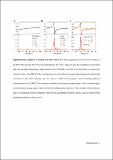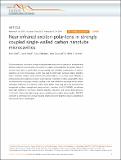Files in this item
Near-infrared exciton-polaritons in strongly coupled single-walled carbon nanotube microcavities
Item metadata
| dc.contributor.author | Graf, Arko | |
| dc.contributor.author | Tropf, Laura Christine | |
| dc.contributor.author | Zakharko, Yuriy | |
| dc.contributor.author | Zaumseil, Jana | |
| dc.contributor.author | Gather, Malte Christian | |
| dc.date.accessioned | 2016-10-11T11:30:16Z | |
| dc.date.available | 2016-10-11T11:30:16Z | |
| dc.date.issued | 2016-10-10 | |
| dc.identifier | 245239470 | |
| dc.identifier | 141603f8-cfab-4e0f-ba3b-a2829c922a4a | |
| dc.identifier | 84990913739 | |
| dc.identifier | 000385547200001 | |
| dc.identifier.citation | Graf , A , Tropf , L C , Zakharko , Y , Zaumseil , J & Gather , M C 2016 , ' Near-infrared exciton-polaritons in strongly coupled single-walled carbon nanotube microcavities ' , Nature Communications , vol. 7 , 13078 . https://doi.org/10.1038/ncomms13078 | en |
| dc.identifier.issn | 2041-1723 | |
| dc.identifier.other | ORCID: /0000-0002-4857-5562/work/47136505 | |
| dc.identifier.uri | https://hdl.handle.net/10023/9640 | |
| dc.description | This research was financially supported by the European Research Council under the European Union's Seventh Framework Programme (FP/2007-2013)/ERC Grant Agreement No. 306298 (EN-LUMINATE) and under the European Union’s Horizon 2020 Framework Programme (FP/2014-2020)/ERC Grant Agreement No. 640012 (ABLASE), by EPSRC through the CM-DTC (EP/L015110/1) and by the Scottish Funding Council through SUPA. J.Z. thanks the Alfried Krupp von Bohlen und Halbach-Stiftung via the “Alfried Krupp Förderpreis für junge Hochschullehrer” for general support. | en |
| dc.description.abstract | Exciton-polaritons form upon strong coupling between electronic excitations of a material and photonic states of a surrounding microcavity. In organic semiconductors the special nature of excited states leads to particularly strong coupling and facilitates condensation of exciton-polaritons at room temperature, which may lead to electrically pumped organic polariton lasers. However, charge carrier mobility and photo-stability in currently used materials is limited and exciton-polariton emission so far has been restricted to visible wavelengths. Here, we demonstrate strong light-matter coupling in the near infrared using single-walled carbon nanotubes (SWCNTs) in a polymer matrix in a planar metal-clad cavity. By exploiting the exceptional oscillator strength and sharp excitonic transition of (6,5) SWCNTs, we achieve large Rabi splitting (> 110 meV), efficient polariton relaxation and narrow band emission (< 15 meV). Given their high charge carrier mobility and excellent photostability, SWCNTs represent a promising new avenue towards practical exciton-polariton devices operating at telecommunication wavelengths. | |
| dc.format.extent | 7 | |
| dc.format.extent | 1415177 | |
| dc.format.extent | 1797051 | |
| dc.language.iso | eng | |
| dc.relation.ispartof | Nature Communications | en |
| dc.subject | QC Physics | en |
| dc.subject | T Technology | en |
| dc.subject | DAS | en |
| dc.subject.lcc | QC | en |
| dc.subject.lcc | T | en |
| dc.title | Near-infrared exciton-polaritons in strongly coupled single-walled carbon nanotube microcavities | en |
| dc.type | Journal article | en |
| dc.contributor.sponsor | European Research Council | en |
| dc.contributor.sponsor | EPSRC | en |
| dc.contributor.sponsor | BBSRC | en |
| dc.contributor.institution | University of St Andrews. School of Physics and Astronomy | en |
| dc.contributor.institution | University of St Andrews. Biomedical Sciences Research Complex | en |
| dc.identifier.doi | 10.1038/ncomms13078 | |
| dc.description.status | Peer reviewed | en |
| dc.identifier.grantnumber | 640012 | en |
| dc.identifier.grantnumber | EP/L015110/1 | en |
| dc.identifier.grantnumber | BB/J000337/1 | en |
This item appears in the following Collection(s)
Items in the St Andrews Research Repository are protected by copyright, with all rights reserved, unless otherwise indicated.


